
The Messerschmitt Me 163 Komet is a rocket-powered interceptor aircraft primarily designed and produced by the German aircraft manufacturer Messerschmitt. It is the only operational rocket-powered fighter aircraft in history as well as the first piloted aircraft of any type to exceed 1,000 kilometres per hour (620 mph) in level flight.

The Messerschmitt Me 262, nicknamed Schwalbe in fighter versions, or Sturmvogel in fighter-bomber versions, is a fighter aircraft and fighter-bomber that was designed and produced by the German aircraft manufacturer Messerschmitt. It was the world's first operational jet-powered fighter aircraft.

The Heinkel He 162 Volksjäger was a German single-engine, jet-powered fighter aircraft fielded by the Luftwaffe in World War II. Developed under the Emergency Fighter Program, it was designed and built quickly and made primarily of wood as metals were in very short supply and prioritised for other aircraft. Volksjäger was the Reich Air Ministry's official name for the government design program competition won by the He 162 design. Other names given to the plane include Salamander, which was the codename of its wing-construction program, and Spatz ("Sparrow"), which was the name given to the plane by the Heinkel aviation firm.

The Mikoyan-Gurevich MiG-9 was the first turbojet fighter developed by Mikoyan-Gurevich in the years immediately after World War II. It used reverse-engineered German BMW 003 engines. Categorized as a first-generation jet fighter, it suffered from persistent problems with engine flameouts when firing its guns at high altitudes due to gun gas ingestion. A number of different armament configurations were tested, but none solved the problem. Several different engines were evaluated, but none were flown as the prototype of the MiG-15 promised superior performance.

The Heinkel He 176 was a German experimental rocket-powered aircraft. It was the world's first aircraft to be propelled solely by a liquid-fueled rocket, making its first powered flight on 20 June 1939 with Erich Warsitz at the controls.

The Henschel Hs 132 was a World War II dive bomber and interceptor aircraft of the German Luftwaffe that never saw service. The unorthodox design featured a top-mounted BMW 003 jet engine and the pilot in a prone position. The Soviet Army occupied the factory just as the Hs 132 V1 was nearing flight testing, the V2 and V3 being 80% and 75% completed.

The Sukhoi Su-9 was an early jet fighter built in the Soviet Union shortly after World War II. The design began in 1944 and was intended to use Soviet-designed turbojet engines. The design was heavily influenced by captured German jet fighters and it was subsequently redesigned to use a Soviet copy of a German turbojet. The Su-9 was slower than competing Soviet aircraft and it was cancelled as a result. A modified version with different engines and a revised wing became the Su-11, but this did not enter production either. The Su-13 was a proposal to re-engine the aircraft with Soviet copies of the Rolls-Royce Derwent turbojet as well as to modify it for night fighting, but neither proposal was accepted.

The Yakovlev Yak-19 was a prototype Soviet fighter built in late 1940s. It was the first Soviet aircraft to be equipped with an afterburning turbojet, the Klimov RD-10F that was derived from the German Jumo 004 engine. Only two examples were built as it was rejected for service by the Soviet Air Force.

The Lippisch P.12, P.13a and P.13b were related design projects for a ramjet-powered delta wing interceptor aircraft studied in 1944 by German designer Alexander Lippisch. The P.12 and P.13a were unarmed, relying on reinforced wings to ram its opponent. The P.13a and b were to be powered by powdered coal. The DM-1 was a full-size glider, flown to test the P.12/13a low-speed aerodynamics. The design series were unrelated to the earlier P.13 produced by Messerschmitt's Lippisch design office.
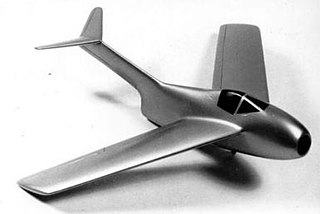
The Focke-Wulf Ta 183 Huckebein was a design for a jet-powered fighter aircraft intended as the successor to the Messerschmitt Me 262 and other day fighters in Luftwaffe service during World War II. It had been developed only to the extent of wind tunnel models when the war ended, but the basic design was further developed postwar in Argentina as the FMA IAe 33 Pulqui II. The name Huckebein is a reference to a trouble-making raven from an illustrated story in 1867 by Wilhelm Busch.

The Emergency Fighter Program was the program that resulted from a decision taken on July 3, 1944 by the Luftwaffe regarding the German aircraft manufacturing companies during the last year of the Third Reich.
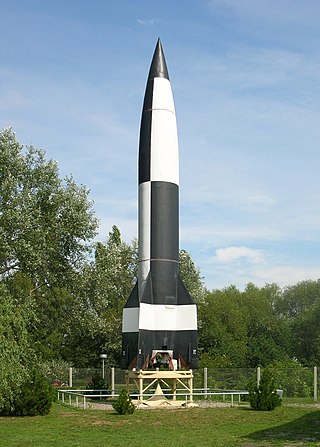
Wunderwaffe is a German word meaning "wonder-weapon" and was a term assigned during World War II by Nazi Germany's propaganda ministry to some revolutionary "superweapons". Most of these weapons however remained prototypes, which either never reached the combat theater, or if they did, were too late or in too insignificant numbers to have a military effect.
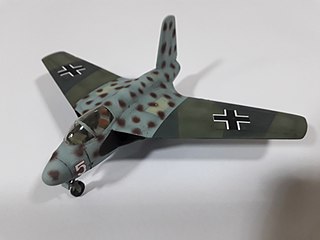
The Lippisch P.15 was a proposed World War II German fighter aircraft.

The Messerschmitt P.1101 was a single-seat, single-jet fighter project of World War II, developed as part of the 15 July 1944 Emergency Fighter Program which sought a second generation of jet fighters for the Third Reich. A prominent feature of the P.1101 prototype was that the sweep angle of the wings could be changed before flight, a feature further developed in later variable-sweep aircraft such as the Bell X-5 and Grumman XF10F Jaguar.
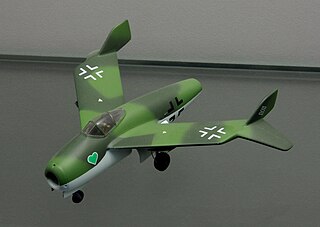
The Blohm & Voss P 212 was a proposed jet fighter designed by Blohm & Voss for the Emergency Fighter Program Luftwaffe design competition during the Second World War.
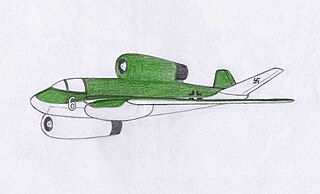
The Heinkel P.1073, known also as Strahljäger, was a fighter project developed for the Luftwaffe by Heinkel aircraft manufacturing company during the last years of World War II.

The Messerschmitt P.1110 was a design for a single-seat, high-altitude interceptor, prepared for the German Luftwaffe by the Messerschmitt aircraft manufacturing company, under the Emergency Fighter Program during the last months of World War II.

The Focke-Wulf Volksjäger, meaning "People's Fighter" in German, was a German emergency fighter project for the Luftwaffe. It was designed by Focke-Wulf industries towards the end of World War II as part of the defense effort against the devastating Allied bombing raids.
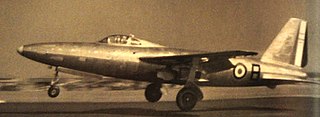
The Sud-Ouest SO.6020 Espadon (Swordfish) was a French post-war prototype interceptor designed and built by SNCASO during the late 1940s. The French Air Force judged the design a failure despite some records being set and cancelled plans to put it into service in 1951. Only four aircraft were built and they were later modified to serve as testbeds for the mixed rocket and turbojet-powered SNCASO SO.9000 Trident program. Only one badly damaged aircraft survives.

The Messerschmitt Me 262 was a German World War II fighter aircraft built by Messerschmitt in the later stages of the war, and under license by Avia post-war.




















